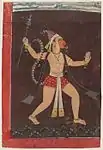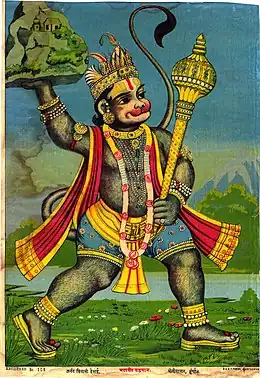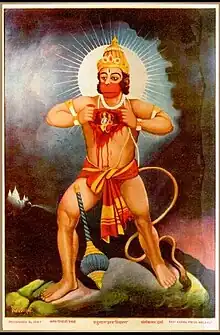List of Hindu temples in Varanasi
Varanasi is an ancient city in India famous for housing many Hindu temples. The city's ancient holiness makes it a sacred geography in Hinduism. The city's temples were erected at different times throughout the history of Varanasi by various kings, saints, monasteries, guilds and communities. The city is one of the largest collection of historic and newly built Hindu temples. Varanasi is an ancient city with deep spiritual roots and significance for the Hindus and it reflects this heritage in over a thousand temples.
_-_1922.jpg.webp)
Varanasi, also known as Benares,[1] Banaras (Banāras), or Kashi (Kāśī), is the holiest of the seven sacred cities (Sapta Puri) in Hinduism and Jainism, and played an important role in the development of Buddhism. It is one of the oldest continuously inhabited cities in the world. Varanasi is also known as the favourite city of the Hindu deity Shiva.[2][3]
Some historic Hindu temples in Varanasi were demolished and mosques built in their place after the 13th-century, particularly in the reign of Aurangzeb.[4][5] Along with the destruction of Hindu temples in Varanasi, Aurangzeb tried to change the name of the city from Benares to Muhammadabad.[6] Sites such as the Kashi Vishwanath Temple / Gyanvapi Mosque are a disputed site, a source of claims and counterclaims of religious intolerance.[7][8]
Shiva
.jpg.webp)
- Kashi Vishwanath Temple: Kashi Vishwanath Temple is one of the most famous Hindu temples and is dedicated to Shiva. This is one of the most worshiped Shiva temple in Hinduism and has been mentioned in the Puranas including the Kashi Khanda (section) of Skanda Purana. The original Vishwanath temple was destroyed by the army of Qutb-ud-din Aibak in 1194 CE, when he defeated the Raja of Kannauj as a commander of Mohammad Ghori. The temple has been destroyed and rebuilt several times in the past 800 years and the existing structure was erected in 18th century.
- Kaal Bhairav Mandir: Kaal Bhairav Mandir is an ancient temple of Varanasi near the main Post Office, Vishesharganj. Kaal Bhairav is believed to be the guardian deity of Varanasi.
- Mrityunjay Mahadev Mandir: Mrityunjay Mahadev Mandir of Shiva is situated on the route from Daranagar to the Kalbhairav temple. Just beside this temple there is a well of much religious importance. Its water is said to be a mixture of several underground streams and good for eliminating several diseases.
- New Vishwanath Mandir (Birla Mandir): The New Vishwanath Mandir, also called Birla Mandir, mainly funded by Birla family, was built as a replica of the old Kashi Vishwanath Temple. Planned by Madan Mohan Malaviya, the temple is part of the Banaras Hindu University campus, and represents national revival. The temple is open to people of all castes and religions. There are nine temples in the Sri Vishwanath Temple campus, including Vishwanath (Lingam), Nataraja, Parvati, Ganesha, Saraswati, Panchamukhi Mahadev, Hanuman, and Nandi. There are idols of Shiva and Lakshmi Narayana.

 New Vishwanath Temple side view
New Vishwanath Temple side view
- Shri Tilbhandeshwar Mahadev Mandir: Shri Tilbhandeshwar Mahadev Mandir is one of the oldest temples in Varanasi, located near Bengal Tola Inter College and next to the famous weavers colony of Madanpura. It is said that, here, Tilbhandeshwar Shiva Lingam increases by a nominal length every year. Besides Tilbhandeshwar Mahadev, Vibhandeshwar, Parvati, Bhairava, Ayyappan and other Hindu deities are visible here. This temple represents a unique combination of Malyali and Banarsi culture. Famous celebrations here include Mahashivaratri, Makar Sankranti, Shravan, Navratri, Ayyappan Puja etc.
- Nepali Mandir: Constructed in the 19th century A.D by the King of Nepal, Maharajadhiraja Rana Bahadur Shah, the temple is a replica of the Pashupatinath Temple in Kathmandu. Temple is also known as Kanthwala Mandir and Mini Khajuraho.
- Ratneshwar Mahadev temple is the leaning temple near the Manikarnika Ghat (the Burning Ghat). A lower part of the temple remains submerged into the river at times making it impossible to perform worship and rituals.[9][10]
Vishnu
In addition to Shiva temples, some of the most important ancient temples in Varanasi are dedicated to Maha Vishnu.[11]

- Adi Keshava temple is one of the oldest temples in Kashi and is considered as the oldest temple of Kashi, The temple finds a mention in the Kashi Khanda of the Skanda Puranam. This temple is considered to be older than Kashi Vishwanath Temple.
- Manikarnika Ghat Vishnu temple
- Bindu Madhav temple
Durga or her Avatar
- Durga Kund Mandir: The architecture of Durga Mandir is of a Nagara style, which is typical of North India. The temple has a rectangular tank of water called the Durga Kund ("Kund" meaning a pond or pool.) The temple has multi-tiered spires and is stained red with ochre, representing the red colour of Durga. The Kund was initially connected directly to the river thus the water was automatically replenished. This channel was later closed, locking off the water supply, which is replenished only by rain or drainage from the Temple. Every year on the occasion of Nag Panchami, the act of depictingVishnu reclining on the coiled-up mystical snake or "Shesha" is recreated in the Kund.
 Durga Mandir main gate
Durga Mandir main gate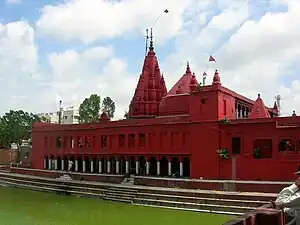 18th century Durga Temple, overlooking the Durga Kund
18th century Durga Temple, overlooking the Durga Kund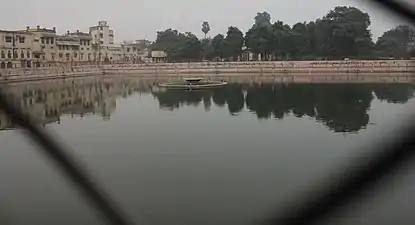
- Sankata Devi Mandir: Sankata Devi Mandir is situated near the Sindhia Ghat, there is an important temple of the "Goddess of Remedy", Devi Sankatha. Inside its premises there is a huge statue of a lion. There are also nine temples of nine planets near to this temple
Hanuman
- Sankat Mochan Mandir: Sankat Mochan Mandir is dedicated to Hanuman. It is very popular with locals. It is the location for many yearly religious as well as cultural festivals. On 7 March 2006 one of the three explosions carried out by Islamic militants hit the temple, while the aarti, in which numerous worshippers and wedding attendees participated, was in progress.[12]
Parvati
- Annapurna Devi Mandir: Annapurna Devi Mandir is located near the Kashi Vishwanath temple, there is a nice temple of Devi Annapurna, believed to be the "Goddess of Food". She is a form of Parvati. She is also known as Kashipuraadeeshwari ("Queen of Kasi").
 Annapurna Devi
Annapurna Devi
- Lalita Gauri Mandir: Temple dedicated to the goddess Lalita Gauri.
- Vishalakshi Temple: Vishalakshi Temple is dedicated to Vishalakshi (means wide-eyed) or Parvati, the consort of Shiva.
Vishnu
In addition to Shiva and Shakti temples, some of the most important ancient temples in Varanasi are dedicated to Vishnu.[13]
- Adi Keshava temple
- Manikarnika Ghat Vishnu temple
- Bindu Madhav temple
Surya
Varanasi has been home to numerous Surya-related temples.[14] Predominently Surya is worshipped in following twelve forms in Varanasi.[15][16]
Others
- Bharat Mata Mandir: Bharat Mata Mandir ("Mother India Temple") is located on the Mahatma Gandhi Kashi Vidyapith campus in Varanasi, India. Instead of traditional statues of Gods and Goddesses, this temple has a huge map of undivided India carved in marble. This temple is dedicated to Mother India and is the only one of its kind in the world.[17]
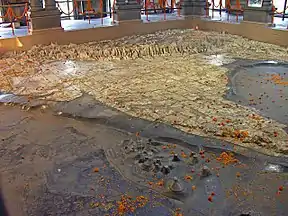 Relief map of India in Bharat Mata Mandir
Relief map of India in Bharat Mata Mandir
Bhojpuri Maai Mandir
Bhojpuri Maai Mandir ("Mother Bhojpuri Temple") is a temple in which the presiding deity is Bhojpuri Maai, representing the Bhojpuri language. This temple is located in Jeevandeep Public School campus, Baralalpur, Varanasi, India.[18] There are around 150 million Bhojpuriyas in the world and they give Bhojpuri language the same status as their mother. It is the only temple in the world for worshipping a language as a god or goddess.[19]
Dhanvantari
In Varanaseya Sanskrit Vishwavidyalaya, Varanasi, Uttar Pradesh state, one statue of Dhanvantari is present in the University museum.
Maharaja Divodas(Grand son of Dhanvantari First king of Kashi) One Black stoned statue facing south is situated in a personal property of a Brahman family in Chowk area, varanasi. It's said that the Idol was found beneath the premises of that property when it was getting constructed and the Brahman couldn't figure out who it was hence decided to have it drifted in Ganga next morning, however same night lord came in his dream and introduced himself as KashiRaja Divodas and asked to remain his idol where it was found, hence he built this temple in his house and his successors are still serving the deity there. This temple said to be quite awakened and spiritual as the idol emerged on its own and it is a local belief that if someone worships here with all his faith, deity cures his illness. Address- CK 14/42, Nandan Sahu Lane
Saints and scholars
- Tulsi Manas Mandir: Tulsi Manas Mandir is dedicated to Rama. It is situated at the place where Tulsidas, the great medieval seer, lived and wrote the epic "Shri Ramcharitmanas", which narrates the life of Rama, the hero of the Ramayana. Verses from Tulsidas’ epic are inscribed on the walls. It is close to the Durga Temple.
- Vyasa Mandir: Situated in Ramnagar, Vyasa Mandir is dedicated to Vyasa, author of the Mahabharata
Damage and destruction
Varanasi and its Hindu temples were a target for raids and destruction during the Islamic invasion and rule of the Indian subcontinent. Various Sultans and Mughal emperors demolished Hindu temples and built mosques in their place starting in late 12th-century, particularly between the 13th-century and 18th-century, such as in the reign of Aurangzeb.[4][5] The destruction of Hindu temples in Varanasi was widespread over time, with Aurangzeb even trying to change the name of the city from Benares to Muhammadabad.[6]
See also
References
As of this edit, this article uses content from "Sri Kushmanda Durga Devi Temple", which is licensed in a way that permits reuse under the Creative Commons Attribution-ShareAlike 3.0 Unported License, but not under the GFDL. All relevant terms must be followed.
- The name that appears on the 1909 version official map of India
- "Varanasi".
- "Varanasi".
- Wendy Doniger (2010). The Hindus: An Alternative History. Oxford University Press. pp. 537–538. ISBN 978-0-19-959334-7.; Quote: "He [Aurangzeb] destroyed all newlybuilt or rebuilt Hindu temples and replaced them with mosques; in particular, he replaced the great Vishvanatha Temple in Varanasi and Keshava Deo Temple at Mathura with two great Aurangzeb mosques and changed the name of Mathura to Islamabad."
- Diana L. Eck (1982). Banaras, City of Light. Columbia University Press. p. 82. ISBN 978-0-231-11447-9.; Quote: "Jayachandra was beheaded, his army was humiliated, and the forces of Muhammad Ghuri, under the leadership of General Qutb-ud-din Aibak, advanced to Varanasi. They sacked and looted the city. According to a Muslim historian of the age, they destroyed nearly one thousand temples in Varanasi alone (...)"
- Diana L. Eck (1982). Banaras, City of Light. Columbia University Press. pp. 83–85. ISBN 978-0-231-11447-9.
- Ron E. Hassner (2009). War on Sacred Grounds. Cornell University Press. pp. 57, 71, 161. ISBN 0-8014-6040-9.
- Brajamādhaba Bhaṭṭācārya (1999). Varanasi Rediscovered. Munshiram Manoharlal. pp. 215–216, 249–251. ISBN 978-81-215-0860-5.
- Varanasi: Part of 500-year-old Ratneshwar mahadev temple collapses due to lightning, DNA 13 Mar 2016
- किसके श्राप से टेढ़ा हुआ था यह मंदिर, भरा रहता है कीचड़, पढ़ें 5 MYTHS, Dainik Bhaskar 14 Mar 2016
- Diana L. Eck (1982). Banaras, City of Light. Columbia University Press. pp. 65–67. ISBN 978-0-231-11447-9.
- Sengupta, Somini (9 March 2006). "Indian City Shaken by Temple Bombings". The New York Times. Retrieved 4 December 2008.
- Diana L. Eck (1982). Banaras, City of Light. Columbia University Press. pp. 65–67. ISBN 978-0-231-11447-9.
- Diana L. Eck (1982). Banaras, City of Light. Columbia University Press. pp. 77–81. ISBN 978-0-231-11447-9.
- "All Places of Worship of Lord Surya (Aditya) in Kashi - Varanasi Temples". Retrieved 30 May 2019.
- "Dwadash Aditya Yatra Virtual Tour : : Official Website of Pawan Path". Retrieved 30 May 2019.
- "Bharat Mata Mandir". varanasi.org. Retrieved 24 June 2015.
- "दुनिया भर में प्रसिद्ध हो रहा भोजपुरी माई मंदिर, 10 देशों की है प्रमुख भाषा, जानें- इसका इतिहास". Dainik Jagran (in Hindi). Retrieved 18 October 2023.
- "वाराणसी में स्थापित हुआ देश का पहला 'भोजपुरी माई' का मंदिर". Navbharat Times (in Hindi). Retrieved 18 October 2023.
